#Hymn Revival
Explore tagged Tumblr posts
Text
instagram
1 note
·
View note
Text











Athenian Architecture
The Antiquities of Athens by Scottish archaeologist James "Athenian" Stuart (1713-1788) and British architect Nicholas Revett (1720-1804), originally published 1762-1830, contains five volumes. Printed in London by German-born John Haberkorn, this was to be his best-known work.
James Stuart and his friend Nicholas Revett embarked on a journey to Greece in 1751. Their mission was to record and measure antiquities, a task no one had accurately accomplished before. Despite facing numerous challenges, including threats from Turkish gangs, their unwavering dedication led to the first accurate survey of ancient Greek architecture completed between 1751 and 1754.
The illustrations in the volumes are not merely decorative; they consist of meticulously etched and engraved plates featuring buildings, maps, plans, and friezes. These illustrations are instrumental in providing a comprehensive visual survey of ancient Greek architecture, allowing readers to appreciate the precision and scale of the antiquities documented.
The particular building featured here is the Choragic Monument of Lysicrates, commonly called the Lanthorn of Demosthenes. It was built around 334 BCE and is the only surviving example of a choragic monument. This monument is situated near the eastern end of the Acropolis, one of Athens's most significant archaeological sites. In ancient Greece, a choragus was a wealthy citizen who financed a production at one of the city's festivals. The monument was originally surmounted by a bronze tripod commemorating Lysicrates’ sponsorship of the chorus that had won first prize at the City Dionysia festival.
Stuart and Revett were the first to recognize the story depicted on the frieze. It is the story of Dionysus, the god of wine and revelry, and the Tyrrhenian pirates. In the Hymn to Dionysus in the Homeric Hymns, the god is kidnapped by pirates who fail to recognize him as a god. The pirates attempt to bind him but are unsuccessful. Instead, Dionysus drives them to jump overboard. Once they’re in the water, he uses his divine gifts to turn them into dolphins, as illustrated here in the depictions of the monument's friezes.
View another post from The Antiquities of Athens.
View other Classics posts.
-- Melissa, Special Collections Undergraduate Classics Intern
#Classics#athens#greece#The Antiquities of Athens#Choragic Monument of Lysicrates#James “Athenian” Stuart#Nicholas Revett#greek mythology#greek revival#greek gods#greek architecture#greek archaeology#architecture#choragus#dionysus#baccus#pirates#mythology#ancient greek#ancient greece#ancient history#Hymn to Dionysus#homeric hymns#frieze#lysicrates#festivals#Dionysia
66 notes
·
View notes
Text

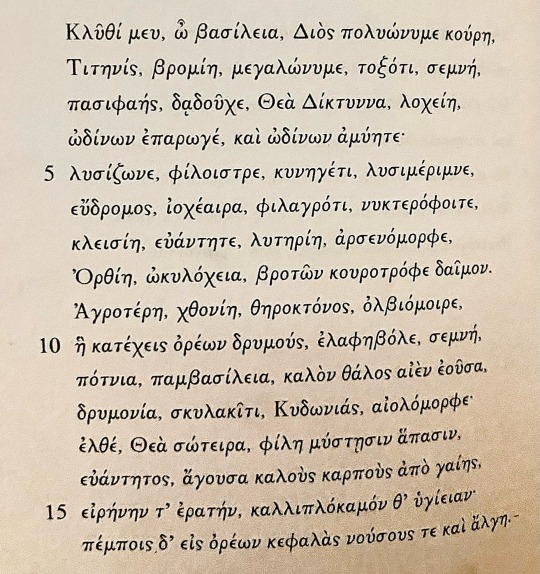
«Άκουσον με, ώ βασίλισσα, του Διός πολυώνυμη Κόρη,
Τιτανίδα, βροντερή, μεγαλώνυμη, τοξότρια, σεμνή,
πασιφανής, δαδούχε, Θεά Δίκτυννα, λοχεία,
‘σύ η αρωγός στις ωδίνες, χωρίς η ίδια σ’ωδίνες να μετέχεις·
λυσίζωνη, εκστατική, κυνηγήτρια, λυσιμέριμνη,
εύδρομη, βελεσιχαρής, φιλαγρότη, νυκτερόφοιτη,
κλειδούχα, ευαπάντητη, λυτρωτική, αρρενόμορφη,
Ορθία, ταχυγέννα, παιδοτρόφα θεότητα των θνητ��ν,
Αγροτέρα, χθόνια, θηροκτόνα, δότειρα της όλβιας μοίρας,
‘σύ που κατέχεις τους δρυμούς των ορέων, ελάφους βάλλοντας, σεμνή,
σεβαστή, παμβασίλεια, που έχεις ωραίο θάλος εσαεί,
δρυμονία, σκυλακίτιδα, Κυδωνιάς, ποικιλόμορφη·
Έλα, θεά σώτειρα, αγαπητή σε όλους τους μύστες,
ευαπάντητη, φέρνοντας καλούς καρπούς από την γαία,
αλλά και την ποθητήν ειρήνη και την καλλιπλόκαμην υγεία·
κι είθε να στέλνεις στις κεφαλές των ορέων τις νόσους και τα άλγη.- »
Orphic Hymn to Artemis ~ Translated to Modern Greek
#hellenic pagan#hellenic polytheism#hellenic religion#hellenic polytheistic#hellenic reconstructionism#hellenic revivalism#hellenism#hellenismos#paganism#artemis#Artemis worship#Artemis devotee#artemis devotion#Artemis deity#lady artemis#Orphic hymns
57 notes
·
View notes
Text
Today's co-op adventure: I had someone hop into my world who wanted me to a) show them where Apep's domain was, and b) run it with them for an achievement. Since I need its drops for Clorinde I of course said yes, and I gave them a summary of what to expect and then we dropped in, me with Keqing (whose burst is great for the swarms in the middle stage) and Bennett (because I always need a healer on the last stage), them with Arlecchino and Furina. We rocked the first two stages, and by "we" I mean "their Arlecchino," but when we got to the last stage the Aftershocks of the Apocalypse took them out almost instantly (I swear I warned them! they just didn't get in the shield fast enough :'> ) and I ended up taking nearly ten minutes whittling the Warden down with Keqing and Bennett, who do not synergize well. XD;;; I usually pair Keqing with Kaeya or Xingqiu or Xiangling, y'know, constant applicators, which Bennett isn't.... But his healing still carried me to victory! And they got their achievement, so it all worked out. \o/
4 notes
·
View notes
Video
youtube
"Bringing In The Sheaves" (with Lyrics) Old-Fashioned Bluegrass Gospel R...
2 notes
·
View notes
Text



@lunarscaled: knock knock they're here to peruse her uhhhhh wares (bodies. they want to examine the quality of her dead bodies for their "pet project")


THEY'RE HERE EARLY. Seems like work never ends for the young DEALER OF DEATH. The immortal gives a sigh, dramatical and complete as she looked at them playfully. ❝ Someone is eager. COME IN. Let's begin. ❞
#lunarscaled#✞. in character. ➛ deceiver of the damned.#✞. ask. ➛ hymns for the holy.#[ time to revive the dead in a funky style ASDFVGVFD ]
1 note
·
View note
Text
Maggie’s pendants and good omens
Yes, you’ve read it right. This post is going to deal with some literal good omens, not just title drop! But first things first, let’s take a closer look at the topic of this analysis.


A toucan
The top necklace is a lovely design involving a crowned toucan — believed to be a messenger of gods able to travel between the spiritual and the physical world, often associated with rain and rainbow (a Christian symbol of divine love, grace, and mercy, a reminder of the covenant between God and humanity to spare the latter from future trials like the Flood) — encircled by a gold band (a symbol of infinity, eternal love and promise) spun by a small butterfly (a symbol of transformation, hope, and rebirth). All three symbols combined seem to deliver a divine message of hope for rebirth, possibly resurrection, and the eternal life. Very fitting in the context of the Second Coming.
The fact that toucans were revered by the native South Americans as rainbringers strengthens the symbolic meaning of another type of bird we can spot on Maggie’s clothes in the very first episode, as her character introduction — a swallow. Swallows flying low are also believed to be harbingers of rain and bad weather. If you see one close to Earth or a building, it means that there’s a storm — or a certain biblical tempest — on the horizon.
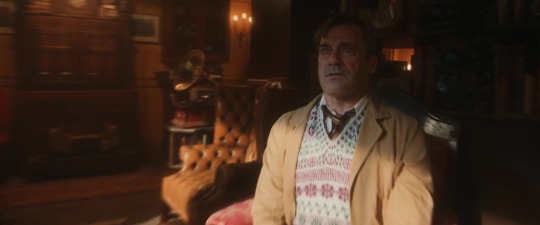
In Ancient Greece and Rome swallows were representing Aphrodite, goddess of love. In Christianity they were considered to be of God and symbolized hope, awakening, and revival of life as messengers of spring and protectors from winter colds. Also helped Jesus on the Cross — according to a Christian legend, a group of swallows was supposed to take out the thorns from the Crown of Thorns and alleviate His Passion on the Cross. Humans banding together in the name of good have been a big theme in the series ever since The Them made an appearance, and from what we already know about the unpublished Good Omens sequel, we can assume that Jesus is going to take the spotlight in the upcoming season.
Maggie definitely attracts sudden inexplicable weather changes, like a thunderstorm with weirdly localized lightning strikes or a sudden downpour. And we’re still waiting for some vavooming (and the following happy ending) to happen in S3.

A heart with an eye
Now, the more nuanced clue hidden in the bottom necklace. I know that some of us were trying to tackle the concept of Maggie’s eye in a heart pendant suggesting her Masonic connotations, but this symbol (or the Eye of Providence in general) isn’t strictly Masonic, it isn’t even limited only to Judeo-Christian art. And while it is used a lot in Christian iconography, we should focus on a very specific example of it already referenced in the show.
Buckle up, we’re making a parachute dive into S1.
It seems like our old friend, Agnes Nutter, still has our backs.

Prophecy 4020:
Let the wheel of fate turne, let harts enjoin, there are othere fyres than mine; when the whirl wynd whirls, reach oute one to another.
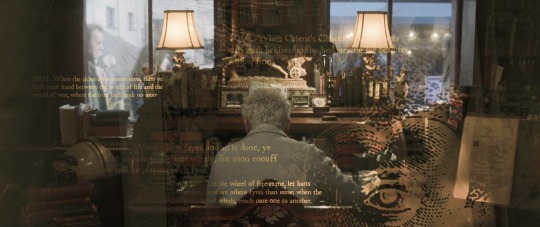
If you look closely at the bottom right corner of this frame, you will see that as an illustration for the above prophecy the production team chose a 1611 engraving titled The Minde should have a fixed Eye On Objects, that are plac’d on High first found in Gabriel Rollenhagen’s Nucleus emblematum selectissimorum.
In 1635 it was published in A Collection of Emblemes, Ancient and Moderne Quickened With Metrical Illustrations, both Morall and Divine, Etc by George Wither with the accompanying hymn:

A Heart, which bore the figure of an Eye
Wide open to the Sunne; by some, was us'd,
When in an Emblem, they would signifie
A Minde, which on Celestiall Matters mus'd:
Implying, by the same, that there is nought
Which in this lower Orbe, our Eyes can see,
So fit an Object for a manly thought,
As those things, which in Heav'n above us be.
God, gave Mankinde (above all other Creatures)
A lovely Forme, and upward-looking Eye,
(Among the rest of his peculiar Features)
That he might lift his Countenance on high:
And (having view'd the Beauty, which appeares
Within the outward Sights circumference)
That he might elevate above the Sphæres,
The piercing Eye, of his Intelligence.
Then, higher, and still higher strive to raise
His Contemplations Eyes, till they ascend
To gaine a glimpse of those eternall Rayes,
To which all undepraved Spirits tend.
For, 'tis the proper nature of the Minde
(Till fleshly Thoughts corrupt it) to despise
Those Lusts whereto the Body stands inclin'd;
And labour alwayes, upward to arise.
Some, therefore, thought those Goblins which appeare
To haunt old Graves and Tombes, are Soules of such,
Who to these loathsome places doomed were,
Because, they doted on the Flesh too much.
But, sure we are, well-minded Men shall goe
To live above, when others bide below.
And hey, guess what 4020, i.e., the number of the prophecy, symbolizes in Strong’s Concordance? Periergazomai, a Greek word meaning “to waste one's labor about something” — to meddle, going beyond proper boundaries (where a person doesn't belong); to fixate on what others are doing, instead of doing what the person himself is supposed to do.
It appears only once in the Bible:
2 Thessalonians 3:11: We hear that some among you are idle and disruptive. They are not busy; they are busybodies. Such people we command and urge in the Lord Jesus Christ to settle down and earn the food they eat. And as for you, brothers and sisters, never tire of doing what is good.
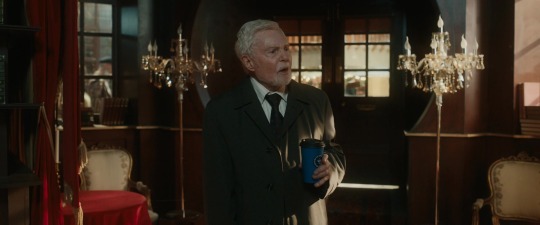
To make things slightly more interesting, in the Hebrew version of Strong’s Concordance 4020 has another meaning — migbaloth, meaning “twisted things, i.e. cords”. Which doesn’t make much sense until we read the actual passage:
Exodus 28:24 and two chains of pure gold, twisted like cords; and you shall attach the corded chains to the settings.
And compare it to the most recent post on the topic published directly by Word of God:

What if all these clues didn’t apply to Maggie and Nina, but Aziraphale and Crowley instead? What if Maggie served as a messenger — consciously or not — just like the toucan, delivering the prophecy to those who need it most?
“When the tempest comes and darkness and great storms, and the dead will leave their graves and walk the Earth once more and there will be great lamentations for the end is near, don’t lose hope, hold hands and look up.”
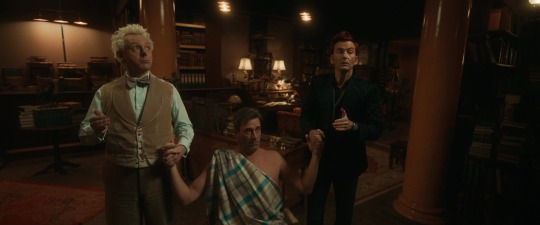
Basically what Aziraphale and Crowley already did when they performed the 25 Lazarii miracle, only with no interference from Gabriel this time around.
And, if both Strong’s Concordance and Maggie’s personal addition to her second pendant are to be believed, with a wedding band somehow involved in the process.
#everything has a meaning#the invisible and unbreakable line that joins Crowley and Aziraphale#two chains of pure gold twisted like cords#never tire of doing what is good#don’t lose hope#hold hands and look up#the good omens crew is unhinged#good omens props#good omens costumes#the nice and accurate prophecies of agnes nutter#agnes nutter#good omens#maggie service#good omens meta#good omens analysis#strong’s concordance#yuri is doing her thing#ineffable husbands#wedding bands
98 notes
·
View notes
Note
Something I've wondered about 19th century spiritualism and seances, how did that overlap with the various denominations of christianity in that era? Were seances and spiritualism not seen as inherently satanic back then?
Some people may have felt that they were satanic, but Spiritualism had a massively Christian bent. Seances often involved the singing of hymns or other overtly Christian practices.
Which makes sense, because the majority of the practitioners were Christian, as were the audiences true believer and scam artist alike sought to attract. If you really believe, you're hardly going to want to go against your own religion- if you're just looking to draw crowds, you shouldn't seem to go against theirs. (There were pagan revival movements in the late 19th century US and UK specifically, but as I understand it, they didn't have much overlap with mainstream Spiritualism of the sort we generally imagine.)
Keep in mind also that this was a time of increasing public trust in science and secular authority- most of them were less concerned about the devil, when they heard claims of spectral communication, and more about being conned. Despite, again, being majority-Christian.
Interestingly, folk magic with a Christian bent goes back much further than the 19th century, with certain prayers or invocations of Jesus, saints, etc. that involve so much ritual as to basically be spells. Looking into the practices of cunning-folk in medieval and early modern England will shed a bit more light on that, if you're interested. We are the daughters of the people who were arguably closer to actual witches but accused innocents to deflect suspicion from themselves and therefore didn't get burned.
90 notes
·
View notes
Note
Hi there! I've recently taken more of an interest in Hellenism, but I don't at all know where to start. I've never really been religious before, only really knowing the basics of Christianity. I did see you created a post of advice for beginner Hellenists, but I was wondering, if it's not too much trouble, if you had any additional information for someone like me who's just starting out.
Hello anon! Sorry for how long it took to write this up, I definitely went a little bit wild on this one :)
First off, welcome to Hellenic Polytheism! It's definitely a wild ride, but depending on what sect of Christianity you come from, it's not completely and totally foreign.
Starting off with a list of some websites, general resources, and accounts that I have found helpful:
theoi.com
Apostolos Athanassakis translations of the Orphic and Homeric Hymns
Hellenic Polytheism: Household Worship by Labrys
Hellenion.org
@khaire-traveler's Subtle Worship Master List
@thegrapeandthefig's Wordpress
And now breaking them all down, because I love when people justify their choices to me :)
theoi.com The nice thing about this website is that it's about as much information about the Gods as you can possibly want in one place. Not only does it seemingly have just about every possible deity in the Greek pantheon, but it has an incredibly good collection of historical references, family trees, and even artwork from ancient Greece.
Apostolos Athanassakis translations While theoi.com is good, I'm not the biggest fan of the version of the translations that they use for the Orphic and Homeric Hymns - they're a bit too "translated" for me. This meaning that the translations in question don't sit too close to the original text, and in my opinion, if you're trying to understand a deity through some ancient work, you want to get the closest translation to the original, even if that means sacrificing some of the flowery language. And Athanassakis' translations are some of my favorite for those "close translation" hymns. You can find his work on the Internet Archives.
Hellenic Polytheism: Household Worship I think this is one of those staples that every Hellenic Polytheist should take a look at at least once. It's pretty dry, but within it, there are plenty of rituals and general information on Hellenism as a religion. I don't use most of the rituals in it, but even still, I keep a copy on hand for the future when I'm able to practice more freely.
Hellenion.org This is a pretty good resource for more modern Hellenic Polytheist prayers, as well as rituals. This is a more heavy reconstructionist lean (which focuses on an accurate recreation of Hellenic Polytheism, as opposed to revivalism, which focuses on recreating it for the modern day), but still incredibly helpful, and a bit easier to understand than Hellenic Polytheism: Household Worship.
@khaire-traveler's subtle worship masterlist Honestly, if a resource like this existed when I was first starting out, I would be light years ahead of where I am now. Stag has managed to fit just about every idea you'd need to get started with worship/offerings into an easy-to-digest format, and I find myself going back to it time and time again when I start incorporating a new deity into my practice.
@thegrapeandthefig's Wordpress I don't even think I could summarize how amazing Aurora is into one little paragraph. There's everything on her Wordpress from historical offerings, to modern festivals, to dissections of various ancient customs. One of the things which has helped me the most from her blog has been her Attic calendar, which shows the schedule of the various religious observations throughout the year (and there are a lot).
Finally, a few extra words of advice that I might not have included in my original post that you mentioned in the ask:
Try to have one prayer memorized for each deity, if you're easily able to memorize things. Chances are, after about a year or so, you'll probably have a prayer or two that you really like and will have memorized because you've said it enough (I definitely have my fair share). And there's definitely something nice about finding yourself in a situation that reminds you of your deity and being able to just rattle off a prayer.
Try to avoid TikTok for your spiritual knowledge. But, if you want to add a bit of Hellenic flair to your FYP, I'd recommend Bria Melitta and hesiodic (who's also on here and maybe on TikTok as well [I might be wrong, haven't been on TikTok in a hot minute] under the name @olympianbutch). Both of these creators are really good, and I especially love Dagan for his devotion to Zeus, who often gets a bad rap from new practitioners because of behavior attributed to Him in myths.
Other than the resources I mentioned, some good stuff for casual reading would be: the Iliad and the Odyssey, any ancient Greek plays (I'd recommend starting with Aristophanes, if the tragedies are a bit too heavy), and Hesiod's Theogony.
And that's about all I can possibly think of throwing at you right now! I hope this came in handy, and as always, if you have more questions, please feel free to drop more in my ask box :) I'm always more than happy to answer questions and help to the best of my ability!
37 notes
·
View notes
Text
instagram
0 notes
Text

Lord of the Dead Marcy, and Bringer of Spring Anne that I did for me and @wren-writes-things's Hymn to Sasha Waybright AU
Loosely based on the greek myth of Hades & Persephone, where Anne heads to the Underworld to get help reviving the Plantars killed by the wrath of Sasha, Goddess of Harvest. And eventually subjected to a devious pomegranate offered to her by Marcy, trapping Anne to her world.
[Designs by Wren. A small birthday present for them, also because this au has had me on a constant chokehold <3]

Taglist: @cowcowwow @hey-its-puddlesock @blightcedas @yourpersonaltimebomb @darcysd20 @waybrights @lili250307 @amisplacedalphabet
#i'mma just say the glowing mushrooms have significance. so much of it (head in hands)#I've had a lot of fun developing it with them. also really enjoyed drawing their designs :3#amphibia#anne boonchuy#marcy wu#sashannarcy#marcanne#amphibia au#Hymn to Sasha Waybright au#hades and persephone au#my art#amphibia fanart
51 notes
·
View notes
Text
In Defence Of Oasis
Exploring the hype behind one of Britain’s most loved and raucous rock n roll bands.

Unless you’ve been living under the most soundproof of rocks this week, you will have heard the news. After a decade and a half of the alluring ‘will-they-won’t-they’ drama, the Gallagher brothers Noel and Liam have rekindled just as suddenly as they’d ended it all backstage at a gig in Paris in 2009.
The rumours abound on social media suddenly began to feel a lot less like fantasies when Oasis, Noel and Liam’s accounts all teased an announcement last Saturday. Oasis had made announcements since their split, usually about anniversaries, merchandise and documentaries, this wasn’t out of the ordinary. In fact, the band would soon be marking 30 years since their era-defining debut album Definitely Maybe came out in August 1994. Singer Liam Gallagher had also threatened to reunite the band on plenty of occasions in the ensuing decade, but never made good on his word. Why should this time have felt different?
In theory, it shouldn’t have. The village eventually loses interest in the boy crying wolf. And yet, when Liam Gallagher stepped onto the Main Stage at Reading festival to perform a headlining set on Sunday and opened with nostalgic on-screen visuals of Oasis, any doubt left in fans’ minds quickly evaporated.
The following Tuesday, the band confirmed what we already knew: Oasis, the biggest Britpop band of the 1990s, were back in action.
The avalanche of articles followed like they hadn’t in over 20 years: Oasis had undoubtedly reignited the fantasies of music magazines and publications that were otherwise scaling down in the face of rising operational costs. We’ve now seen over 20 NME articles, news on the BBC website, a revived radio documentary on BBC 6 Music, countless Rolling Stone thinkpieces, news in SPIN Magazine, the Manchester Evening News, gossip in the rags of the Sun, Mail, Metro. The mural in Manchester. The millions of people that tried to get tickets for the reunion dates that sold out in hours. It’s easy to be sick of it all, to think there wasn’t a band more overrated, overhyped or beloved than Oasis.
But let’s forget the hymns for a moment. Let us re-examine the appeal of the band before the myth: five boys from Manchester who believed in nothing more than the rock ‘n’ roll dream. And certainly, nothing less.
Cast your mind back to 1994, before the success and idolatry, before their songs would be turned into design-for-life anthems, before the band would be permanently woven into the fabric of British music history. Strip all that away and try to imagine hearing a then-relatively unknown Oasis for the first time. Imagine being told that half the band was not yet 22 years old, that they were a new band, releasing their third-ever single? Can you imagine, however simple it may have been lyrically, hearing Live Forever for the first time? In particular, just 4 months after Kurt Cobain’s suicide, after many fans were left feeling like they were staring at the definitive end of an era of honest independent music?
In 1994, Oasis were ’77’s punk all over again. Entering a landscape of artists (a term Liam Gallagher has derided) who internalised their music and recoiled at the notion of explicit success, Oasis were a brash rejection of shoegaze and indie’s philosophies, even going as far as to instruct the presenters of BBC Radio 1’s Evening Sessions to tell the world that Oasis were not an indie band. They were a rock ‘n’ roll band, and a band that dared to aim high, openly and with no apologies (all apologies for the pun).
That was a philosophy they would live by until the bitter end, for better or worse. In a world of falling ambition and no hope, as Britain emerged ravaged by the Thatcher years to find there was nowhere left for its young to go, Oasis were determined to write their own destiny, largely for themselves, but invariably, for their entire generation.
Keep reading
#Oasis#oasis band#oasis reunion#oasis 2025#noel gallagher#liam gallagher#britpop#music#music writing#music journalism#long reads#musicians#UK#British music#British culture#pop culture#pop music#rock n roll#Rock music#Manchester#music magazines#music mag#Using a Keep Reading bc the article is indeed longer. I lost my mind I went mad and wrote and wrote and wrote
22 notes
·
View notes
Text
I finally found the time to watch the Dead Poets Society
Oh my actual fucking god
The callbacks and mirroring between scenes
Neil's wanting to act being an allegory for being gay
The night they revived the Dead Poets Society and how they embraced Mr Keating's teachings
Neil's death being so fucking heartbreaking and the way Todd specifically reacted (+ how Charlie helped him (snow to stop panic attack, giving him space))
Todd's yawp being Neil
Charlie refusing to sing the hymn with everyone else
Every single last scene being the most gut-wrenching, beautiful moment
I am sobbing my traumatised little ass of rn omfg
#dead poets society#dead poets#neil perry#todd anderson#knox overstreet#charlie dalton#richard cameron#steven meeks#gerard pitts
29 notes
·
View notes
Text
Sunlit Gotham Universe Notes
Batfam Notes:
- Due to moving around the batfam timeline a bit, Jason is the only one who has died who has been fully buried and then revived (Steph’s heart stopped for about three minutes when Black Mask captured her, and Damian has not been killed.)
- Damian came to Gotham earlier than canon, and is currently 10 years old and in 4th grade at Gotham Academy
- Jon Kent is also going to be the same age as Damian in this AU
- Jason Todd is going be announced as Legally Alive before the beginning of the story (Yes, he is still Red Hood, but he doesn’t kill anymore (most of the time))
- Bruce will NOT be going missing in time
- This means that Tim never drops out of high school, gets emancipated, and becomes CEO of a company at the age of 17. It also means that Dick will not have been Batman
- Selina and Bruce are dating - he’s gonna probably propose soon, but big life events keep happening (like adopting new children every few months) so he hasn’t yet. He claims he’s waiting for a time when everything is calm. His children call bullshit and say he’s just scared she’ll say no
- Selina totally knows that he already has the ring and is honestly just teasing him and stressing him out more by making comments and jokes every so often
How does Wonder Woman not know about the demigods?
- When the Greek Amazons went to live on Themyscira they became cut off from the rest of the mortal world. This means that they weren’t aware of Camp moving around to follow Olympus
- Diana was born WAY before the First Great Prophecy, and technically isn’t a true demigod because she was sculpted from clay - therefore not really part mortal
- By the time Diana had left the island, demigods had gone underground and general society forgot that they existed. Both camps are kept secret so that the demigods are safe, so Diana hasn’t heard about them and assumes that the demigods are just no more
- Due to the Mist, Off World League Missions, Rescue Ops, and the fact that she lived in Paris for a while, Diana hasn’t been around during any of the major battles - or her focus was elsewhere
- Donna Troy might show up at some point, and the same logic about leaving Themyscira works for her too. We’re going with the Magical Duplicate origin story for her, so again, doesn’t quite count as mortal enough for the prophecy
- Cassie Sandsmark originally used magical artifacts to help Diana fight crime and was later ret-conned into being either a daughter of Zeus or a granddaughter of Zeus. The ret-con is going to be brought up in the story and we can all thank the Flashes for messing up the timeline. But basically she doesn’t become a proper descendant of Zeus until after the Titan War and therefore the prophecy doesn’t apply to her either
Children of Apollo have the following abilities According to the Riordan Wiki:
- They can curse others to only speak in rhyming couplets that can take days or even weeks to wear off (depending on strength and number of people in the spell)
- They are expert archers, inherited from their father. However, the children of Apollo who are healers tend to be less skilled with this (as seen with Will Solace)
- They also excel at anything involving throwing or shooting stuff, like shooting hoops or shooting firearms or other missile weapons
- They are skilled in physical contests and games
- They excel in the arts
- They are skilled musicians
- Vitakinesis: As the children of Apollo, they are natural healers. They can heal people by singing a hymn to their father (in Ancient Greek).
- Audiokinesis: As the children of Apollo, they have the ability to control sound waves and music
- It is extremely rare that a child of Apollo can possess complete photokinesis, as only Apollo himself and the Titan of Light, Hyperion, and the Titan of the Sun, Helios, have been known to use the ability
- From what can be gleaned from The Demigod Diaries, it can be presumed that some, or even all of Apollo's children possess a limited form of precognition
- Thanks to a curse, all the children of Apollo have a terrible fear of snakes
In this AU, souls have auras that are unique to each soul. Demigod children with parent’s who deal with light (ex: Apollo or Iris) can see the auras if they focus really hard. Children of Apollo will often use it as a way to check how well a patient is healing as the brighter the aura the healthier the person.
#sunlitgotham#percy jackson#percy jackon and the olympians#percy jackson oc#batfam#batfamily#fanfic#fanfiction#ao3 writer#ao3 author#archive of our own
163 notes
·
View notes
Text
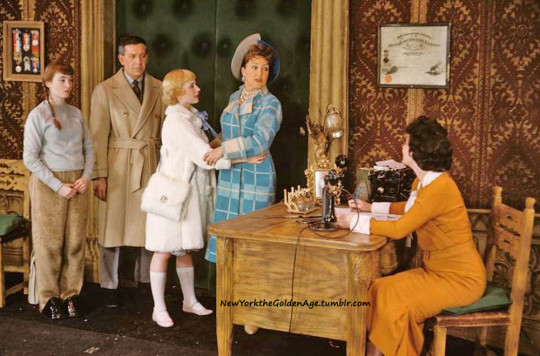
Above: Sandra Church, Jack Klugman, Lane Bradbury, Ethel Merman, and Peg Murray in Gypsy.
Gypsy, the musical based on the memoirs of Gypsy Rose Lee, opened at the newly-refurbished Broadway Theater on May 21, 1959. It had a book by Arthur Laurents, lyrics by Stephen Sondheim, and music by Jule Styne. Originally, Sondheim had been slated to write the music as well as the lyrics, but Ethel Merman was nervous about entrusting the whole thing to such a young man (he was 29). Jerome Robbins directed and choreographed it.
Despite the title, the star of this show is Gypsy's mother, Rose Hovick, the stage mother to end all stage mothers. Often described as monstrous, she ruthlessly pushes her two young daughters into vaudeville, spotlighting the pretty blonde, June. But vaudeville is dying, and the girls are eventually forced into doing their act in burlesque theaters. It is there that one of the dancers persuades Louise, the "plain" brunette daughter, to consider striptease. She blossoms, of course, and becomes the famous stripper Gypsy Rose Lee. Her sister runs away and becomes the actress June Havoc.
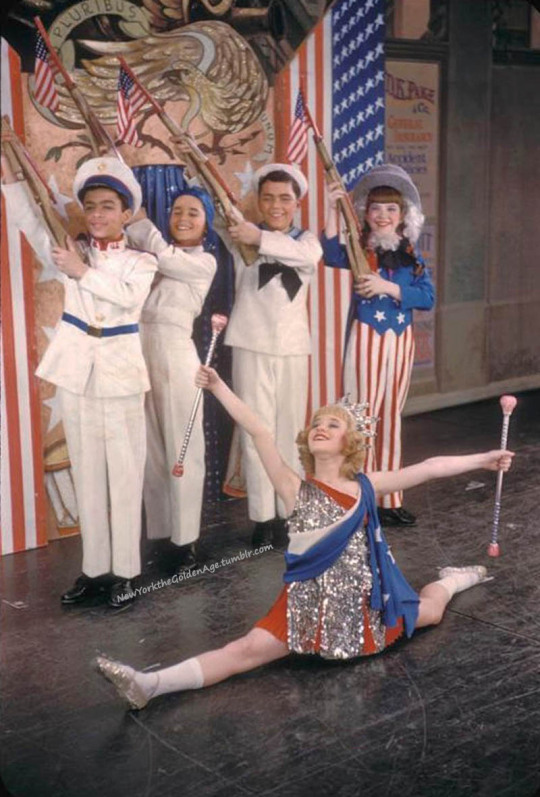

Above: left, Jacqueline Mayro as Baby June (doing split) and Karen Moore as Baby Louise (Uncle Sam). Right, Sandra Church as the adult Gypsy and Ethel Merman as her mother.
The score is chock full of what would become standards: "Let Me Entertain You," "Everything's Coming Up Roses," "You Gotta Get a Gimmick," among others, as well as the most exciting overture in all musical theater. But the crowning musical achievement was the show's final song, "Rose's Turn," which one critic described as a "quick-mix of aria, stomp, anthem, hymn, recitative, shout, [and] wail." It's also the essence of the integrated musical number.

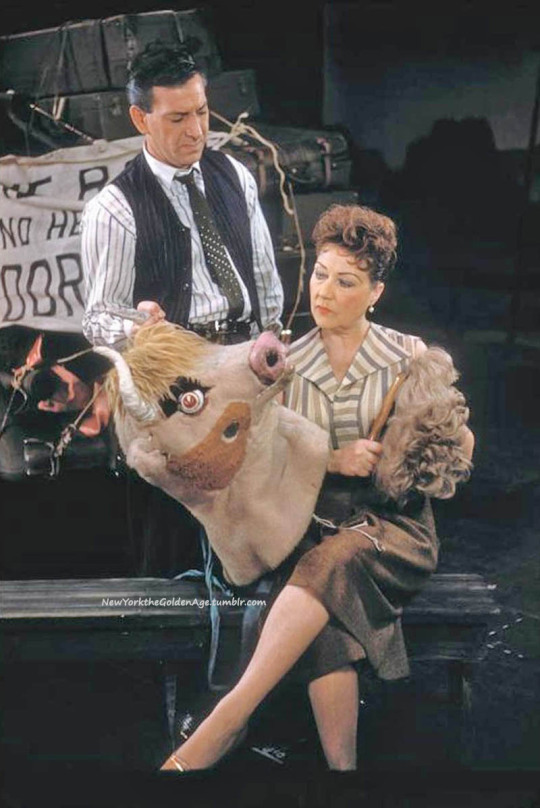
Above: Ethel Merman and Maria Karnilova.. Right, Jack Klugman and Merman.
Gypsy is often mentioned when the question of Best Musical Ever Made comes up. In addition to a film and a television version, it has been revived on Broadway four times; it would have been five if not for Covid. The 2015 West End production, starring Imelda Staunton as a stunning Rose, was supposed to have transferred. But the production is available to watch on DVD.
All photos: Friedman-Abeles via the NYPL. Click/tap on each one to enlarge.
#vintage New York#1950s#Gypsy musical#musical theater#Broadway musical#Jule Styne#Ethel Merman#Stephen Sondheim#Arthur Laurents#Jerome Robbins#stage musical#vintage Broadway#vintage theater#May 21#21 May
44 notes
·
View notes
Text
Just remembered I need to let everyone know that the title of Jeeves and the Tie that Binds is a reference to a hymn called “Blessed Be the Tie That Binds” and these are the lyrics:
1. Blessed be the tie that binds
Our hearts in Christian love;
The fellowship of kindred minds
Is like that to that above.
2. Before our Father's throne
We pour our ardent prayers;
Our fears, our hopes, our aims are one
Our comforts and our cares.
3. We share each other's woes,
Our mutual burdens bear;
And often for each other flows
The sympathizing tear.
4. When we asunder part,
It gives us inward pain;
But we shall still be joined in heart,
And hope to meet again.
5. This glorious hope revives
Our courage by the way;
While each in expectation lives,
And longs to see the day.
6. From sorrow, toil and pain,
And sin, we shall be free,
And perfect love and friendship reign
Through all eternity.
#presented without comment#ok presented with one comment and that comment is that i’m gnawing on the walls#jooster#jeeves and wooster#jeeves and the tie that binds#much obliged jeeves#jeeves books#recommendations for hymns to sing at your wedding
50 notes
·
View notes